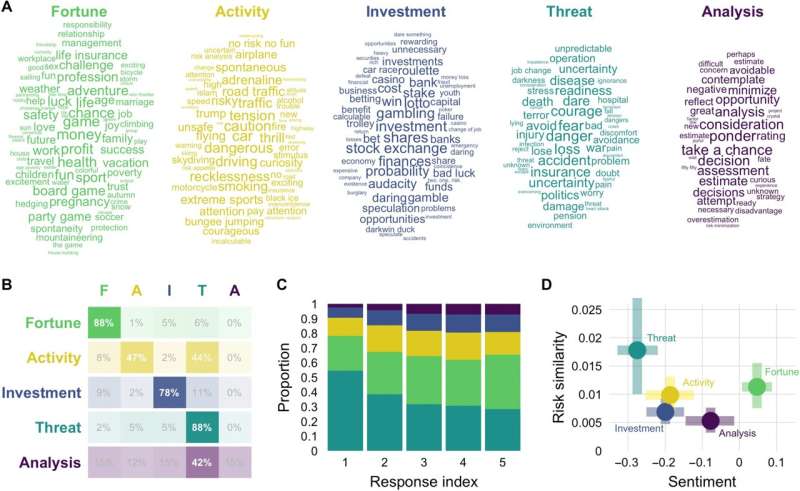A new method for determining how society thinks about risk

From pandemics to nuclear energy, the world is full of risks. Psychologists at the University of Basel have developed a new method of determining how risk is perceived within a society.
Many of our everyday activities involve a certain degree of risk—whether to our work, finances or health. But how is risk perceived within a society and how do individuals think about risk?
This was what Dr. Dirk Wulff and Professor Rui Mata, researchers in the Faculty of Psychology at the University of Basel, set out to discover. "There is a lot of academic interest in the phenomenon of risk," explains Dirk Wulff. "But disciplines such as psychology, sociology and economics define it in different ways."
According to Wulff, little attention has been paid until now to the fact that the meaning of risk can differ from individual to individual depending on goals and life experience. He feels it is important to understand how different people think about risk in order, for example, to gauge attitudes to new technologies or societal challenges.
Risk links polar ends of the sentiment spectrum
To investigate this, the researchers have developed a new method based on word associations and an algorithmic process that maps the representation of risk for different groups and individuals. The researchers adopted a new approach, employing a snowball word association method. Participants were asked to name five things they associated with the term risk and then, in turn, five things they associated with these associations. Using this method, researchers surveyed a nationally representative sample of 1,205 people, with equal representation of men and women and different age ranges.
An algorithm was used to generate a semantic network of risk from the 36,100 associations. It identified the following components: threat, fortune, investment, activity and analysis. The semantic cluster "threat" (danger, accident, loss, etc.) was the component most prominently associated with risk, closely followed by "fortune" (profit, game, adventure). "Up until now, studies have mostly focused on the negative components of risk and ignored the fact that it can also have positive associations," Wulff comments.
The method is designed to map both individual and group-specific differences in risk perception. The psychologists investigated the differences between men and women and between different age groups. Overall, women and men and people of different ages appeared to share similar thoughts about risk. Nevertheless, there were some differences: a higher proportion of older people than younger people and a higher proportion of women than men associated risk more closely with threat and less with fortune.
Small differences between languages
The researchers also posed the question: Do people from different language regions think about risk in a similar way? To investigate this, they compared the semantic network of risk that emerged from the German survey group with those that resulted in two other languages—Dutch and English. There were some small differences in the frequency of associations. For example, in Dutch the term risk tended to be more closely associated with threat and in English more with fortune and finance. Overall, however, the results of the Science Advances study indicate that there are some universal correlations in risk representation that transcend language boundaries.
"Our study lays new foundations for examining the question of how people think about risk," says Wulff. "It could play an important role in helping to provide a better understanding of how different social groups interpret risk, enabling risk communication strategies to be improved to combat social polarization."
More information: Dirk U. Wulff et al, On the semantic representation of risk, Science Advances (2022). DOI: 10.1126/sciadv.abm1883
Journal information: Science Advances
Provided by University of Basel




















